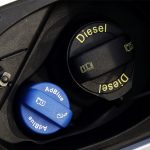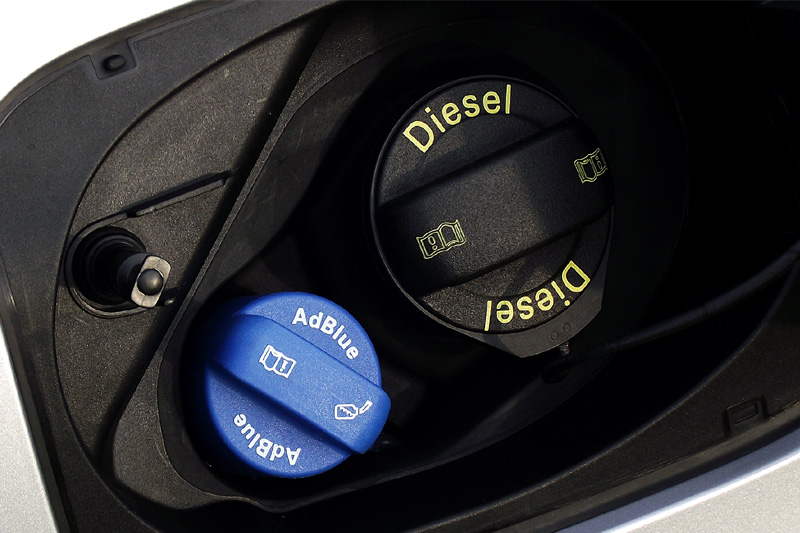Although workshops are yet to see high volumes of vehicles fitted with AdBlue systems, this number will soon increase. We talk to Chris Knight, MD of Permex to find out why the correct equipment is vital for proficient servicing.
A dBlue® is a registered trademark for a high purity 32.5% urea and 67.5% purified watersolution which is injected into the exhaust stream ahead of the catalytic converter. Here the urea reacts with the
exhaust gases in the presence of heat and water, taking the harmful nitrogen oxides (NOx) and converting them into harmless nitrogen and water plus carbon dioxide.
Where should AdBlue go?
Despite its name suggesting that it might be an additive, AdBlue is NOT added to the diesel fuel, windscreen wash, oil or coolant. Instead it is kept in its own separate tank which, on passenger vehicles, may be in the boot, under the back seat, beneath the spare tyre or (more commonly on recent models)
next to the fuel filler.
Care must be taken to fill the correct tank. If AdBlue is added to the fuel and the vehicle is run on the mix, the engine is likely to be an expensive write-off. The filling inlet for AdBlue on passenger cars is designed to an international specification and has an opening which is smaller than the lead-free petrol nozzle, so it should be impossible to put fuel into the AdBlue tank. Take care, however, if you’re using a funnel or some jerry-can spouts.
How to stop misfilling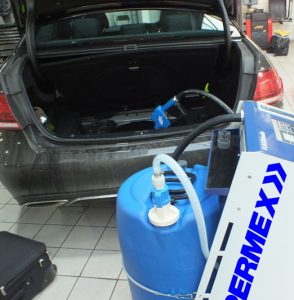
Some bottles and cheaper filling systems allow AdBlue to be filled into any tank, but this can lead to expensive errors. More sophisticated systems – such as the Flaco Blue 60 machine for cars and vans – have an automatic cut-off nozzle with sensors which won’t allow filling to start unless the nozzle is securely located in the AdBlue filler pipe.
Contaminated AdBlue is a killer
If AdBlue® is contaminated it can cause expensive damage to the vehicle’s catalytic converter. Such contamination can be caused by simply using the wrong materials – such as zinc, aluminium, copper and brass – in contact with the fluid.
To avoid this problem it is vital that the storage tanks, hoses, pipes, pumps, meters and valves must be specifically chosen to be compatible with the AdBlue. It’s not just a
matter of whether the component itself will be adversely affected by the urea but, more importantly, whether it will leach chemicals into the AdBlue which will “poison” the catalytic converter. If AdBlue has been removed from a vehicle’s tank it should never be re-used.
Storage of AdBl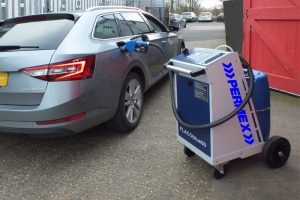 ue
ue
The storage of AdBlue should always be in accordance with the manufacturer’s recommendations, which normally suggest that it should be kept out of direct sunlight in a cool place. Storing it at 25 ºC can halve the “shelf life” of the same product stored at 10ºC, however if it gets too cold (below –11.5ºC) it will freeze. Once it has been fully de-frosted, it can be used without detriment but problems can occur when it is partially frozen as the water molecules will form ice before the urea freezes and so the concentration of any liquid used at this point will be outside of the specified parameters.
Urea crystals – unsightly and unpleasant
AdBlue forms crystals when it is allowed to evaporate and these can cause wear and damage to pumps, seals, meters etc. These crystals are easily dissolved again when they are immersed in more AdBlue and agitated. The design of any AdBlue distribution system should avoid air pockets where crystallisation
can take place and any build-up of crystals around a filling nozzle should be wiped off with a rag soaked in de-ionised water.
The connector to any bulk supply may be fitted with a self-seal connector. This needs to be kept free of crystals, otherwise the valve mechanism can become jammed slightly open and air, rather than fluid, will be pumped. If AdBlue is spilt within the car boot or elsewhere inside a vehicle it c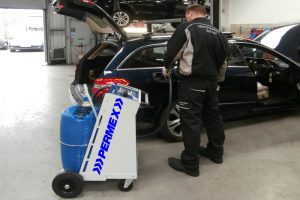 an lead to unattractive crystal build-up and an unpleasant smell of ammonia as it breaks down. Spillage of AdBlue over the vehicle’s bodywork can damage the paintwork, but using an automatic cut-off drip free nozzle will prevent that problem.
an lead to unattractive crystal build-up and an unpleasant smell of ammonia as it breaks down. Spillage of AdBlue over the vehicle’s bodywork can damage the paintwork, but using an automatic cut-off drip free nozzle will prevent that problem.
What if a spillage occurs?
Urea mixes with water and so it can’t be removed from surface water in the event of a spillage, as it won’t be separated out in an oil interceptor. It is relatively harmless to humans but is an environmental pollutant that can cause algal bloom in ponds and rivers. It’s important, therefore, that it is kept away from water courses and surface water drains.
Any filling/transfer should take place where there is an impervious hard-standing and a spill kit should be at hand to mop up any spillage as an Environment Agency officer has been reported to have said that even a small spillage could lead to them taking action.
Beware of substandard solutions
AdBlue is a relatively low cost product but, even so, there are some companies that are selling a diluted version (marketed as ‘automotive urea solution’). If it has been handled correctly, only been in contact with suitable materials and diluted with pure de-ionised water, it may not actually harm the vehicle, but using it will void most warranties and increase the consumption as the vehicle’s sensors in the exhaust will call for more fluid to correct the emissions. If you buy urea in sealed containers labelled ‘AdBlue’ it will be to the correct standard.
AdBlue filling – a new business opportunity
“One workshop user calculated that the cost of the time saved using this machine would pay for itself in less than three months, without even allowing for the saving in AdBlue costs by buying it in larger containers.”
Finding somewhere to fill up with AdBlue is currently a difficult task for car owners. By offering a top-up service in your workshop you could attract a new pool of customers, but filling needs to be quick, efficient, reliable and profitable.
The best and quickest method is to use a filling machine, like the Flaco Blue 60. This ‘go anywhere’ battery operated unit has an intelligent electric sensor nozzle that makes it impossible to fill the diesel tank with AdBlue and it shuts off immediately once the correct level is sensed.
It’s extremely fast and can even be latched on to fill hands-free so your operative can carry on with something else during the fill time. One workshop user calculated that the cost of the time saved using this machine would pay for itself in less than three months, without even allowing for the saving in
AdBlue costs by buying it in larger containers.

